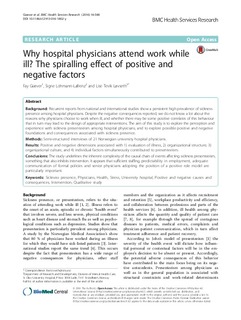| dc.contributor.author | Giæver, Fay | |
| dc.contributor.author | Lohmann-Lafrenz, Signe | |
| dc.contributor.author | Løvseth, Lise T | |
| dc.date.accessioned | 2017-10-06T09:49:38Z | |
| dc.date.available | 2017-10-06T09:49:38Z | |
| dc.date.created | 2016-11-07T09:34:42Z | |
| dc.date.issued | 2016 | |
| dc.identifier.citation | BMC Health Services Research. 2016, 16:548 (1), 1-7. | nb_NO |
| dc.identifier.issn | 1472-6963 | |
| dc.identifier.uri | http://hdl.handle.net/11250/2458887 | |
| dc.description.abstract | Background: Recurrent reports from national and international studies show a persistent high prevalence of sickness presence among hospital physicians. Despite the negative consequences reported, we do not know a lot about the reasons why physicians choose to work when ill, and whether there may be some positive correlates of this behaviour that in turn may lead to the design of appropriate interventions. The aim of this study is to explore the perception and experience with sickness presenteeism among hospital physicians, and to explore possible positive and negative foundations and consequences associated with sickness presence. Methods: Semi-structured interviews of 21 Norwegian university hospital physicians. Results: Positive and negative dimensions associated with 1) evaluation of illness, 2) organizational structure, 3) organizational culture, and 4) individual factors simultaneously contributed to presenteeism. Conclusions: The study underlines the inherent complexity of the causal chain of events affecting sickness presenteeism, something that also inhibits intervention. It appears that sufficient staffing, predictability in employment, adequate communication of formal policies and senior physicians adopting the position of a positive role model are particularly important. | nb_NO |
| dc.language.iso | eng | nb_NO |
| dc.publisher | BioMed Central | nb_NO |
| dc.rights | Navngivelse 4.0 Internasjonal | * |
| dc.rights.uri | http://creativecommons.org/licenses/by/4.0/deed.no | * |
| dc.title | Why hospital physicians attend work while ill? The spiralling effect of positive and negative factors | nb_NO |
| dc.type | Journal article | nb_NO |
| dc.type | Peer reviewed | nb_NO |
| dc.description.version | publishedVersion | nb_NO |
| dc.source.pagenumber | 1-7 | nb_NO |
| dc.source.volume | 16:548 | nb_NO |
| dc.source.journal | BMC Health Services Research | nb_NO |
| dc.source.issue | 1 | nb_NO |
| dc.identifier.doi | 10.1186/s12913-016-1802-y | |
| dc.identifier.cristin | 1397869 | |
| dc.description.localcode | © The Author(s). 2016. This article is distributed under the terms of the Creative Commons Attribution 4.0 International License (http://creativecommons.org/licenses/by/4.0/), which permits unrestricted use, distribution, and reproduction in any medium, provided you give appropriate credit to the original author(s) and the source, provide a link to the Creative Commons license, and indicate if changes were made. The Creative Commons Public Domain Dedication waiver (http://creativecommons.org/publicdomain/zero/1.0/) applies to the data made available in this article, unless otherwise stated. | nb_NO |
| cristin.unitcode | 194,67,40,0 | |
| cristin.unitname | Institutt for psykologi | |
| cristin.ispublished | true | |
| cristin.fulltext | original | |
| cristin.qualitycode | 2 | |

